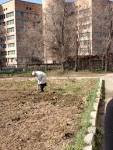 In Russia, there is a " concentrated epidemic of HIV among intravenous drug users ", noted in a statement released on the last working day of the week the annual report of the United Nations office on drugs. In Russia, there is a " concentrated epidemic of HIV among intravenous drug users ", noted in a statement released on the last working day of the week the annual report of the United Nations office on drugs.
"probably every third person in the world who use intravenous drugs and have HIV live in the Russian Federation ", - is informed in the report. While Russia has not only a high degree of dissemination of the epidemic, but also the growing number of new cases, the authors of the report.
according to the report, in different cities of the Russian Federation, the concentration of the epidemic varies. If in Voronezh only 3% of intravenous drug users infected with HIV in Irkutsk, the average is 57%, in St. Petersburg - 59%, and in Ekaterinburg - 64%. In General, in Russia the percentage of people infected with HIV among intravenous drug users is 24, 6 per cent. Another high figure, according to the UN, is celebrated in Ukraine (19, 7 %). In General in the world the spread of HIV among drug users has decreased from 2011 to 2013 by 10%.
The total number of intravenous drug users in Russia is 2, 29 percent of residents in the age range from fifteen to 64, which is almost 2 times more than in General in Eastern and South-Eastern Europe, where the frequency of drug use is Typically five times higher than the global average, according to the report, which analyzes the statistics of 2013.
Deaths from narcotic substances occurs mainly a result of an overdose of opiates and is common in the Nordic countries. In Estonia, Scotland, Finland, Sweden, Northern Ireland, Russia, Norway and Ireland has the highest Mortality rate from drug substances, comprising more than 70 cases per million inhabitants in the age range from fifteen to 64 years, according to the report. In Russia, this number is 80 deaths per million, say the authors of the report.
according to the authors of the report, one of the issues Russia is the fact that it passes through the so-called "Northern route" of drugs from Afghanistan. The report States that although information about the reduction of demand for heroin in Russia, the total number of seizures of shipments of drugs on the "North road" in 2013 decreased, which was due to more effective work by intercepting the supplies within Afghanistan itself. It is also noted that in Russia the process of replacing the heroin with cheaper alternatives - acetylated opium and desomorphine. Also, the UN experts emphasize the growth of cocaine use in Russia.
in General, in the world of drug addiction notes remains stable. According to the report, 246 million, or just over five percent of world inhabitants at the age from fifteen to 64 years had used illicit drugs in 2013. With 27 million people were problematic drug users, of which nearly fifty percent had used drugs intravenously. Men are 3 times more often than women, are marijuana, cocaine and amphetamines, and women are more often abused medical opiates and sedatives.
in circulation with the release of a report by the head of the United Nations office on drugs and crime, the Deputy UN Secretary-General Yury Fedotov said As one of the smaller issues the availability of a drug treatment For women: If among drug users women constituted thirty-one percent, among treatment - only one-fifth. He Also noticed that it is necessary to make more efforts to shape attitudes about addiction As a chronic illness.
"There is no quick and easy cure for addiction, and we must invest in long-term, medical, scientific solutions" - quoted Fedotov in a statement to the UN statement.
according to the health Ministry, every year the number of new cases of HIV infection in the Russian Federation Usually increases by 10%, While at the beginning of 2015 the number of registered HIV cases was estimated at 730 thousand people. To change the difficult situation created by the draft state strategy for improving the diagnosis and treatment of HIV infection in Russia in the 2015-2020 year. As emphasized in the Ministry of health, the main objectives of this plan is to reduce the number of new HIV infections by 25% by 2020 and a reduction of deaths from AIDS by 30%. For example, according to the expert of the Ministry of health, is expected to focus on 2 key groups that determine the development of the epidemic: women with HIV infection (37% of the total HIV-infected) and drug users (57%).
sections: Politics
|